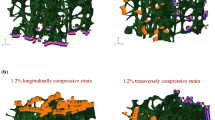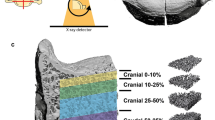Abstract
In this study, we attempt to predict cortical and trabecular bone adaptation in the mouse caudal vertebrae loading model using knowledge of bone’s local mechanical environment at the onset of loading. In a previous study, we demonstrated appreciable 25.9 and 11% increases in both trabecular and cortical bone volume density, respectively, when subjecting the fifth caudal vertebrae (C5) of C57BL/6 (B6) mice to an acute loading regime (amplitude of 8N, 3000 cycles, 10 Hz, 3 times a week for 4 weeks). We have also established a validated finite element (FE) model of the C5 vertebra using micro-computed tomography (micro-CT), which characterizes, in 3D, the micro-mechanical strains present in both cortical and trabecular compartments due to the applied loads. To investigate the relationship between load-induced bone adaptation and mechanical strains in-vivo and in-silico data sets were compared. Using data from the previous cross-sectional study, we divided cortical and trabecular compartments into 15 subregions and determined, for each region, a bone formation parameter ΔBV/BS (a cross-sectional measure of the bone volume added to cortical and trabecular surfaces following the described loading regime). Linear regression was then used to correlate mean regional values of ΔBV/BS with mean values of mechanical strains derived from the FE models which were similarly regionalized. The mechanical parameters investigated were strain energy density (SED), the orthogonal strains (e x , e y , e z ) and the three shear strains (e xy , e yz , e zx ). For cortical regions, regression analysis showed SED to correlate extremely well with ΔBV/BS (R 2 = 0.82) and e z (R 2 = 0.89). Furthermore, SED was found to predict expansion of the cortical shell correlating significantly with the regional percentage increases in cortical tissue volume (R 2 = 0.92), cortical marrow volume (R 2 = 0.91) and cortical thickness (R 2 = 0.56). For trabecular regions, FE parameters were found not to correlate with load-induced trabecular bone morphology. These results indicate that load-induced cortical morphology can be predicted from population data, whereas the prediction of trabecular morphology requires subject-specific micro- architecture.
Similar content being viewed by others
References
Adachi T, Kameo Y et al (2010) Trabecular bone remodelling simulation considering osteocytic response to fluid-induced shear stress. Philos Trans A Math Phys Eng Sci 368(1920): 2669–2682
Bentolila V, Boyce TM et al (1998) Intracortical remodeling in adult rat long bones after fatigue loading. Bone 23(3): 275–281
Biewener AA, Fazzalari NL et al (1996) Adaptive changes in trabecular architecture in relation to functional strain patterns and disuse. Bone 19(1): 1–8
Bonivtch AR, Bonewald LF et al (2007) Tissue strain amplification at the osteocyte lacuna: a microstructural finite element analysis. J Biomech 40(10): 2199–2206
Bouxsein ML, Boyd SK et al (2010) Guidelines for assessment of bone microstructure in Rodents using micro-computed tomography. J Bone Miner Res 25(7): 1468–1486
Boyd SK, Müller R et al (2002) Mechanical and architectural bone adaptation in early stage experimental osteoarthritis. J Bone Miner Res 17: 687–694
Burr DB, Martin RB et al (1985) Bone remodeling in response to in vivo fatigue microdamage. J Biomech 18(3): 189–200
Carpenter RD, Carter DR (2008) The mechanobiological effects of periosteal surface loads. Biomech Model Mechanobiol 7(3): 227–242
Colopy SA, Benz-Dean J et al (2004) Response of the osteocyte syncytium adjacent to and distant from linear microcracks during adaptation to cyclic fatigue loading. Bone 35(4): 881–891
Duncan RL, Turner CH (1995) Mechanotransduction and the functional response of bone to mechanical strain. Calcif Tissue Int 57(5): 344–358
Evans WJ (1998) Exercise and nutritional needs of elderly people: effects on muscle and bone. Gerodontology 15(1): 15–24
Guo XE, Eichler MJ et al (2002) Quantification of a rat tail vertebra model for trabecular bone adaptation studies. J Biomech 35(3): 363–368
Han Y, Cowin SC et al (2004) Mechanotransduction and strain amplification in osteocyte cell processes. Proc Natl Acad Sci USA 101(47): 16689–16694
Hilderbrand T (1999) Direct three-demensional morphometric analysis of human cancellous bone: microstructural data from spine, femur, iliac crest and calcaneus. J Bone Miner Res 14: 1167–1174
Johnell O, Kanis JA (2006) An estimate of the worldwide prevalence and disability associated with osteoporotic fractures. Osteoporos Int 17(12): 1726–1733
Kanis JA, Johnell O (2005) Requirements for DXA for the management of osteoporosis in Europe. Osteoporos Int 16(3): 229–238
Kim CH, Takai E et al (2003) Trabecular bone response to mechanical and parathyroid hormone stimulation: the role of mechanical microenvironment. J Bone Miner Res 18(12): 2116–2125
Kotha SP, Hsieh YF et al (2004) Experimental and finite element analysis of the rat ulnar loading model-correlations between strain and bone formation following fatigue loading. J Biomech 37(4): 541–548
MacNeil JA, Boyd SK (2008) Bone strength at the distal radius can be estimated from high-resolution peripheral quantitative computed tomography and the finite element method. Bone 42(6): 1203–1213
Marcus R (1995) Relationship of age-related decreases in muscle mass and strength to skeletal status. J Gerontol A Biol Sci Med Sci 50: 86–87
Müller R, Rüegsegger P (1995) Three-dimensional finite element modelling of non-invasively assessed trabecular bone structures. Med Eng Phys 17(2): 126–133
Mulvihill BM, Prendergast PJ (2008) An algorithm for bone mechanoresponsiveness: implementation to study the effect of patient- specific cell mechanosensitivity on trabecular bone loss. Comput Methods Biomech Biomed Engin 11(5): 443–451
Norman J, Shapter JG et al (2007) Micromechanical properties of human trabecular bone: a hierarchical investigation using nanoindentation. J Biomed Mater Res A 87(1): 196–202
Prendergast PJ, Taylor D (1994) Prediction of bone adaptation using damage accumulation. J Biomech 27(8): 1067–1076
Price C, Zhou X et al (2011) Real-time measurement of solute transport within the lacunar-canalicular system of mechanically loaded bone: direct evidence for load-induced fluid flow. J Bone Miner Res 26(2): 277–285
Robinson JA, Chatterjee-Kishore M et al (2006) Wnt/beta-catenin signaling is a normal physiological response to mechanical loading in bone. J Biol Chem 281(42): 31720–31728
Robling AG, Hinant FM et al (2002) Improved bone structure and strength after long-term mechanical loading is greatest if loading is separated into short bouts. J Bone Miner Res 17(8): 1545–1554
Rubin C, Judex S et al (2006) Low-level mechanical signals and their potential as a non-pharmacological intervention for osteoporosis. Age Ageing 35: 32–36
Sarver JJ, Elliott DM (2005) Mechanical differences between lumbar and tail discs in the mouse. J Orthop Res 23(1): 150–155
Schulte FA, Lambers FM et al (2011) In vivo micro-computed tomography allows direct three-dimensional quantification of both bone formation and bone resorption parameters using time-lapsed imaging. Bone 48(3): 433–442
Smith IM, Griffiths DV (1998) Programming the finite element method. Wiley, Chichester
Somerville JM, Aspden RM et al (2004) Growth of C57BL/6 mice and the material and mechanical properties of cortical bone from the tibia. Calcif Tissue Int 74(5): 469–475
Vatsa A, Breuls RG et al (2008) Osteocyte morphology in fibula and calvaria—Is there a role for mechanosensing?. Bone 43(3): 452–458
Vatsa A, Semeins CM et al (2008) Paxillin localisation in osteocytes-Is it determined by the direction of loading?. Biochem Biophys Res Commun 377(4): 1019–1024
Warden SJ, Turner CH (2004) Mechanotransduction in cortical bone is most efficient at loading frequencies of 5–10 Hz. Bone 34(2): 261–270
Webster D, Wasserman E et al (2010) Mechanical loading of mouse caudal vertebrae increases trabecular and cortical bone mass-dependence on dose and genotype. Biomech Model Mechanobiol 9(6): 737–747
Webster DJ, Morley PL et al (2008) A novel in vivo mouse model for mechanically stimulated bone adaptation–a combined experimental and computational validation study. Comput Methods Biomech Biomed Engin 11(5): 435–441
Xie LQ, Jacobson JM et al (2006) Low-level mechanical vibrations can influence bone resorption and bone formation in the growing skeleton. Bone 39(5): 1059–1066
Zeng Y, Cowin SC et al (1994) A fiber matrix model for fluid flow and streaming potentials in the canaliculi of an osteon. Ann Biomed Eng 22(3): 280–292
Author information
Authors and Affiliations
Corresponding author
Rights and permissions
About this article
Cite this article
Webster, D., Wirth, A., van Lenthe, G.H. et al. Experimental and finite element analysis of the mouse caudal vertebrae loading model: prediction of cortical and trabecular bone adaptation. Biomech Model Mechanobiol 11, 221–230 (2012). https://doi.org/10.1007/s10237-011-0305-3
Received:
Accepted:
Published:
Issue Date:
DOI: https://doi.org/10.1007/s10237-011-0305-3




